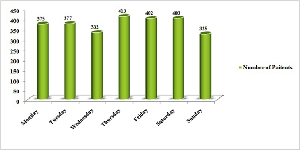Analysis of Patient Data Undergoing Computed Tomography Scans in the Emergency Department to Evaluate the Rates of Acute Pathology Detection According to the Reasons for Presentation
Authors
##plugins.themes.bootstrap3.article.main##
Abstract
Objective: The aim of this study is to analyze the reasons for emergency department visits and the rates of pathological conditions in the imaging results of patients who underwent diagnostic computed tomography scans in the emergency department. Materials and Methods: This study was conducted retrospectively. Patients' reasons for presenting to the emergency department and computed tomography imaging results were evaluated. Data were compared between traumatic and non-traumatic patient groups and between patient groups with and without acute pathology on imaging. Results: Data from 2627 patients were evaluated in the study. 52% percent of the patients were male. The mean age was 46.92±24.58. 59.5% of patients presented with non-traumatic causes. The most common complaint among non-traumatic patients was abdominal pain (21.1%), while the most common complaint among traumatic patients was falling (28.2%). Brain computed tomography scans were the most frequently performed(44.8%). No acute pathological findings were observed in 87.4% of patients. Conclusion: Acute pathology was not seen in the vast majority of computed tomography scans performed in the emergency department. It should be remembered that radiation doses are high in computed tomography, and great care should be taken when requesting diagnostic imaging, and appropriate indications must be determined.
##plugins.themes.bootstrap3.article.details##
Copyright (c) 2025 Mustafa ALPASLAN

This work is licensed under a Creative Commons Attribution 4.0 International License.
Creative Commons License All articles published in Annals of Medicine and Medical Sciences are licensed under a Creative Commons Attribution 4.0 International License.
Mustafa ALPASLAN, Department of Emergency Medicine, Nevsehir Public Hospital, Turkey.
Department of Emergency Medicine, Nevsehir Public Hospital, Turkey.
[1] Yıldız Ozkan O, Eraybar S, Kaya H, Armagan E. How effective are the computerized tomography imaging prompts in the emergency department? J Contemp Med. 2019; 9(3): 249-254. doi: 10.16899/jcm.596718
[2] Hendee WR, Becker GJ, Borgstede JP, Bosma J, Casarella WJ, Erickson BA, et al. Addressing overutilization in medical imaging. Radiology. 2010; 257(1): 240-5. doi: 10.1148/radiol.10100063.
[3] Carnevale TJ, Meng D, Wang JJ, Littlewood M. Impact of an emergency medicine decision support and risk education system on computed tomography and magnetic resonance imaging use. J Emerg Med. 2015; 48(1): 53-57. doi: 10.1016/j.jemermed.2014.07.033.
[4] Mettler FA Jr, Mahesh M, Bhargavan-Chatfield M, Chambers CE, Elee JG, Frush DP, et al. Patient Exposure from Radiologic and Nuclear Medicine Procedures in the United States: Procedure Volume and Effective Dose for the Period 2006-2016. Radiology. 2020; 295(2): 418-427. doi: 10.1148/radiol.2020192256.
[5] Griffey RT, Jeffe DB, Bailey T. Emergency physicians' attitudes and preferences regarding computed tomography, radiation exposure, and imaging decision support. Acad Emerg Med. 2014; 21(7): 768-777. doi: 10.1111/acem.12410.
[6] Erkoc MF, Imamoglu H, Dostbil AB, Okur A. Is cranial CT really required in the emergency department for each patient with headache? Middle East Journal of Medicine. 2012; 4(3): 114-116. https://doi.org/10.16899/jcm.596718.
[7] Bellolio MF, Bellew SD, Sangaralingham LR, Campbell RL, Cabrera D, Jeffery MM, et al. Access to primary care and computed tomography use in the emergency department. BMC Health Services Research. 2018; 18(1):154. doi: 10.1186/s12913-018-2958-4.
[8] Bellolio MF, Heien HC, Sangaralingham LR, Jeffery MM, Campbell RL, Cabrera D, et al. Increased Computed Tomography Utilization in the Emergency Department and Its Association with Hospital Admission. West J Emerg Med. 2017; 18(5): 835-845. doi: 10.5811/westjem.2017.5.34152.
[9] Maxwell S, Ha NT, Bulsara MK, Doust J, Mcrobbie D, O'Leary P, et al. Increasing use of CT requested by emergency department physicians in tertiary hospitals in Western Australia 2003-2015: an analysis of linked administrative data. BMJ Open. 2021; 11(3): e043315. doi: 10.1136/bmjopen-2020-043315.
[10] Cross R, Bhat R, Li Y, Plankey M, Maloy K. Emergency Department Computed Tomography Use for Non-traumatic Abdominal Pain: Minimal Variability. West J Emerg Med. 2018; 19(5): 782-796. doi: 10.5811/westjem.2018.6.37381.
[11] Arslan E, Aydın I, Lök U, Gülaçtı U, Turgut K, Yavuz E, et al. Evaluation of the effectiveness of radiological imaging examinations requested from the emergency department. Adıyaman University Journal of Health Sciences. 2021; 7(2): 136-145. doi:10.30569/adiyamansaglik.874510
[12] Quayle KS, Jaffe DM, Kuppermann N, Kaufman BA, Lee BC, Park TS, et al. Diagnostic testing for acute head injury in children: when are head computed tomography and skull radiographs indicated? Pediatrics. 1997; 99(5):E11. doi: 10.1542/peds.99.5.e11.
[13] Ozturk K, Soylu E, Bilgin C, Hakyemez B, Parlak M. Predictor variables of abnormal imaging findings of syncope in the emergency department. Int J Emerg Med. 2018; 11(1):16. doi: 10.1186/s12245-018-0180-0.
[14] Kapoor WN, Karpf M, Wieand S, Peterson JR, Levey GS. A prospective evaluation and follow-up of patients with syncope. N Engl J Med. 1983; 309(4): 197-204. doi: 10.1056/NEJM198307283090401.
[15] Goyal N, Donnino MW, Vachhani R, Bajwa R, Ahmad T, Otero R. The utility of head computed tomography in the emergency department evaluation of syncope. Intern Emerg Med. 2006; 1(2): 148-50. doi: 10.1007/BF02936543.
[16] Swartzberg K, Goldstein LN. High positive computed tomography yields in the emergency department might not be a positive finding. S Afr Med J. 2018; 108(3): 230-234. doi: 10.7196/SAMJ.2018.v108i3.12635.
[17] Maxwell S, Ha NT, Bulsara MK, Doust J, Mcrobbie D, O'Leary P, et al. Increasing use of CT requested by emergency department physicians in tertiary hospitals in Western Australia 2003-2015: an analysis of linked administrative data. BMJ Open. 2021; 4;11(3):e043315. doi: 10.1136/bmjopen-2020-043315.
[18] Miller DG, Vakkalanka P, Moubarek ML, Lee S, Mohr NM. Reduced Computed Tomography Use in the Emergency Department Evaluation of Headache Was Not Followed by Increased Death or Missed Diagnosis. West J Emerg Med. 2018;19(2):319-326. doi: 10.5811/westjem.2017.12.34886.
[19] ElHabr A, Merdan S, Ayer T, Prater A, Hanna TN, Horný M, et al. Increasing Utilization of Emergency Department Neuroimaging From 2007 Through 2017. AJR Am J Roentgenol. 2022; 218(1): 165-173. doi: 10.2214/AJR.21.25864.
[20] Aşırdizer M, Ekiz A. Proposed Solutions in Medical Malpractice Claims. Forensic Medicine Bulletin 2022;27(3):288-294. doi: 10.17986/blm.1564

